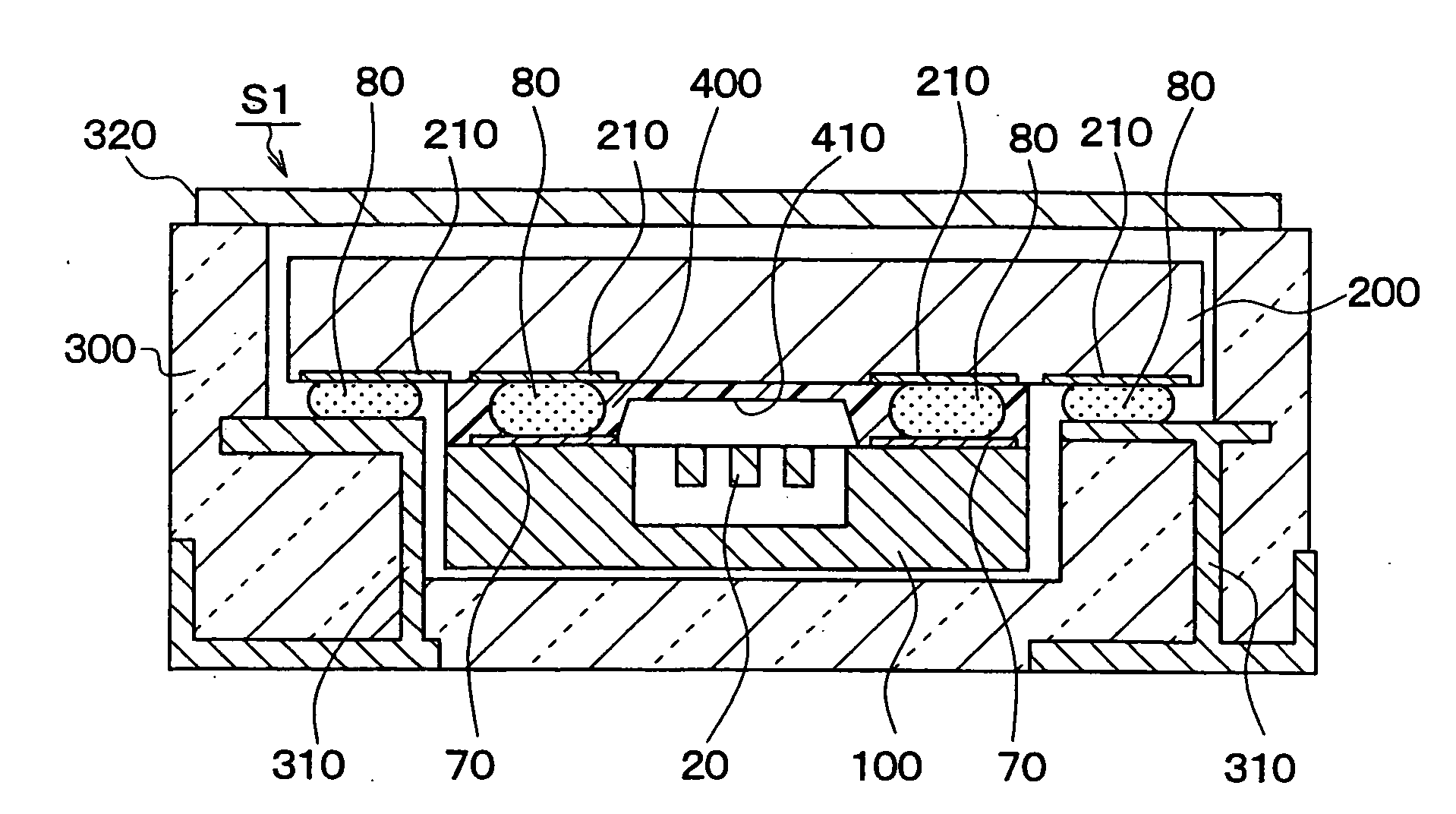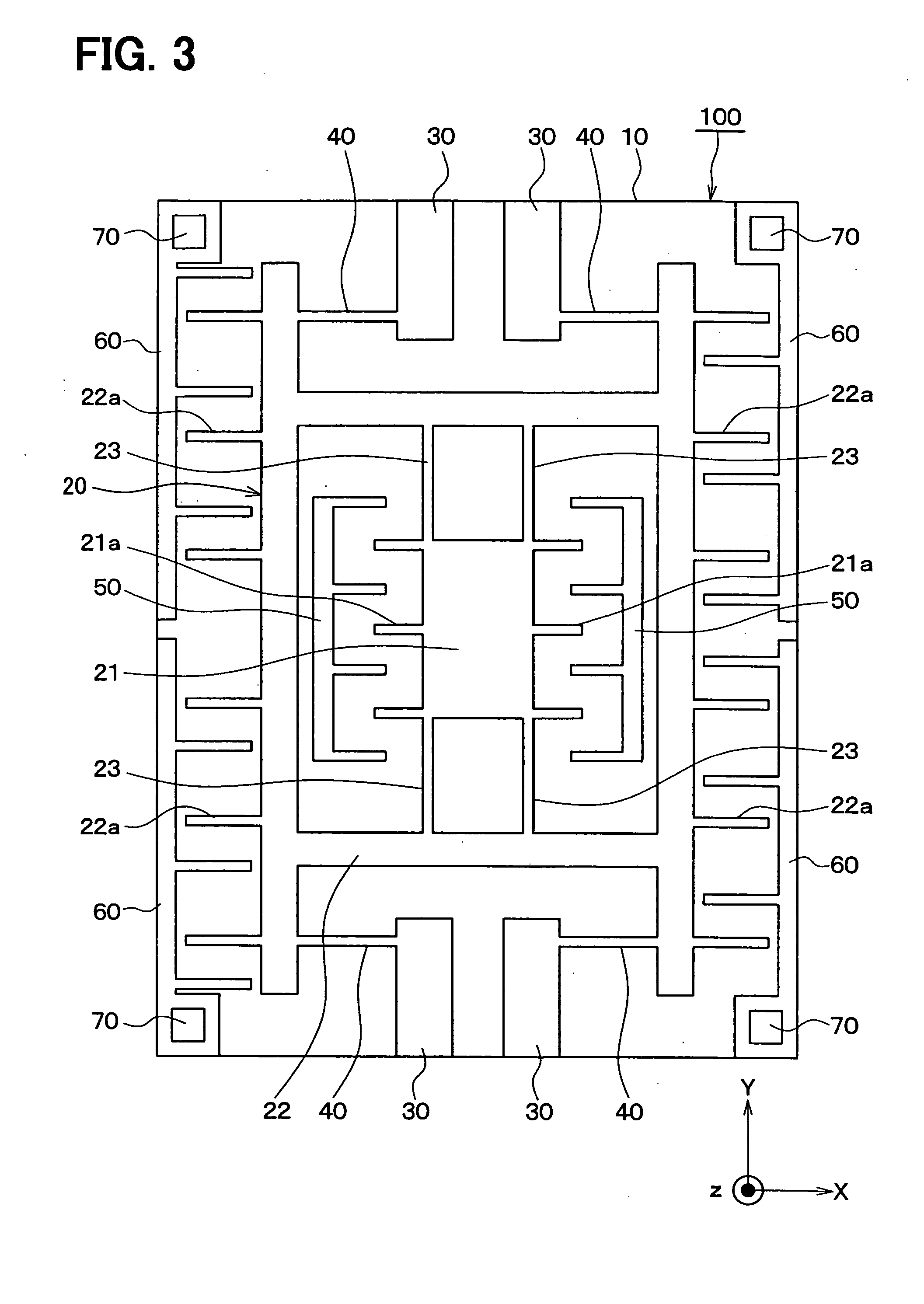Sensor device
a technology of a sensor and a spherical device, which is applied in the direction of turn-sensitive devices, semiconductor/solid-state device details, instruments, etc., can solve the problem of restricting the variation in and achieve the effect of restricting the parasitic capacity of the electric connection portion
- Summary
- Abstract
- Description
- Claims
- Application Information
AI Technical Summary
Benefits of technology
Problems solved by technology
Method used
Image
Examples
first embodiment
[0035]FIG. 1 is a view showing an entire structure of an angular velocity sensor device S1 as a sensor device in accordance with the first embodiment of the present invention. FIG. 2 is a schematic plan view showing a surface structure of a circuit chip 200 having bumps 80 in the angular velocity sensor device S1 shown in FIG. 1 in a transmitting state of a sensor chip 100. FIG. 3 is a view showing a schematic planar structure of an angular velocity detecting element 100 in the angular velocity sensor device S1 shown in FIG. 1 when being viewed from the upper surface of a substrate 10 constituting this element 100.
[0036] As shown in FIG. 1, the angular velocity sensor device S1 of this embodiment is generally formed by arranging the angular velocity detecting element 100 as the sensor chip, the circuit chip 200, and a package 300 for accommodating the angular velocity detecting element 100 and the circuit chip 200.
[0037] First, the angular velocity detecting element 100 will be ma...
second embodiment
[0120]FIG. 11 is a view showing an angular velocity sensor device S2 as a sensor device in accordance with a second embodiment of the present invention.
[0121] In this embodiment, as shown in FIG. 11, similarly to the above first embodiment, in the angular velocity sensor device S2, an angular velocity detecting element (sensor chip) 100 having a vibrator 20 on one surface and a circuit chip 200 are laminated and both these chips 100, 200 are electrically connected. Furthermore, the angular velocity detecting element 100 is laminated with the circuit chip 200 through bumps 80 such that its vibrator 20 is opposed to the circuit chip 200. In addition, both the chips 100, 200 are electrically connected by the bump 80, while the vibrator 20 and the circuit chip 200 are separated by a space through the bumps 80.
[0122] Here, as shown in FIG. 11, in the angular velocity sensor device S2 of this embodiment, the above-described adhesive member is not arranged between the angular velocity de...
third embodiment
[0126]FIG. 12 is a view showing a part of an angular velocity sensor device S3 as a sensor device in accordance with a third embodiment of the present invention.
[0127] In the third embodiment, as shown in FIG. 12, similarly to the above first embodiment, in the angular velocity sensor device S3, an angular velocity detecting element (sensor chip) 100 having a vibrator 20 on one surface and a circuit chip 200 are laminated and both these chips 100, 200 are electrically connected. In addition, the angular velocity detecting element 100 is laminated with the circuit chip 200 through bumps 80 in a state in which its vibrator 20 is opposed to the circuit chip 200, and both the chips 100, 200 are electrically connected by the bumps 80, and the vibrator 20 and the circuit chip 200 are separated by the bumps 80.
[0128] Further, an adhesive member 400 having an electric insulating property for adhering both these chips 100, 200 is arranged between the angular velocity detecting element 100 ...
PUM
 Login to View More
Login to View More Abstract
Description
Claims
Application Information
 Login to View More
Login to View More - R&D
- Intellectual Property
- Life Sciences
- Materials
- Tech Scout
- Unparalleled Data Quality
- Higher Quality Content
- 60% Fewer Hallucinations
Browse by: Latest US Patents, China's latest patents, Technical Efficacy Thesaurus, Application Domain, Technology Topic, Popular Technical Reports.
© 2025 PatSnap. All rights reserved.Legal|Privacy policy|Modern Slavery Act Transparency Statement|Sitemap|About US| Contact US: help@patsnap.com



